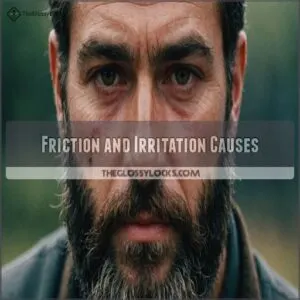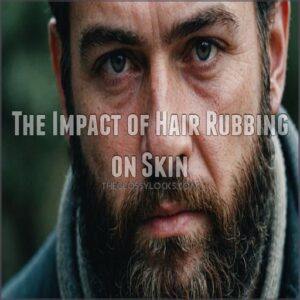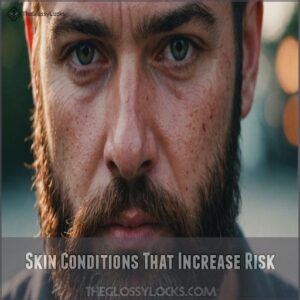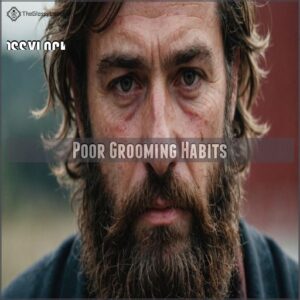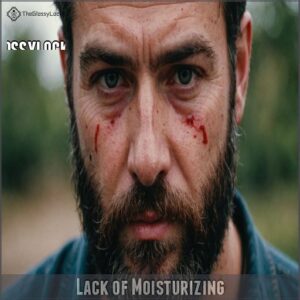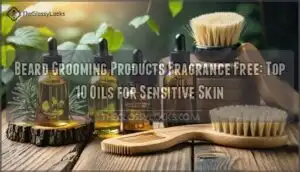This site is supported by our readers. We may earn a commission, at no cost to you, if you purchase through links.
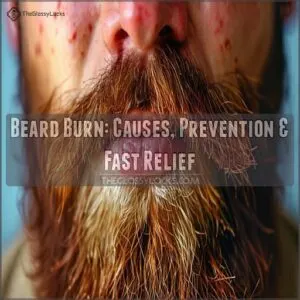 Beard burn‘s most common culprit is the friction between a beard and your skin, usually leading to redness and irritation.
Beard burn‘s most common culprit is the friction between a beard and your skin, usually leading to redness and irritation.
Imagine rubbing sandpaper across your cheek—not fun!
Dry, coarse hair is often the main offender, especially if grooming takes a back seat.
In some cases, sensitive skin or frequent kissing can turn up the heat on this fiery issue.
And let’s not forget sweat and dirt, which add insult to injury by making irritation even worse.
Curious about how to cool the burn or perhaps prevent it altogether?
Keep reading for some surprisingly simple solutions.
Table Of Contents
- Key Takeaways
- Friction and Irritation Causes
- Skin Sensitivity and Beard Burn
- The Role of Sweat and Dirt
- Foods and Drinks That Cause Irritation
- Factors That Exacerbate Beard Burn
- The Impact of Hair Rubbing on Skin
- Beard Length and Style
- Skin Conditions That Increase Risk
- Daily Habits That Exacerbate Beard Burn
- Prevention Through Lifestyle Changes
- Frequently Asked Questions (FAQs)
- How do you prevent beard burn?
- Why does my beard feel like it’s burning?
- What does beard burn look like?
- What causes beard burn from kissing?
- Can beard burn lead to infections?
- How does weather affect beard burn?
- Is beard burn common in teenagers?
- What symptoms indicate severe beard burn?
- Do certain fabrics worsen beard burn?
- Conclusion
Key Takeaways
- Dry, coarse beard hair creates friction, causing irritation and redness on your skin. Regularly using beard oils and conditioners can soften the hair and prevent discomfort.
- Poor grooming habits, like not trimming or washing your beard properly, lead to increased friction and potential beard burn. Maintain a regular beard care routine, including the use of a good beard balm, to keep your beard healthy and soft.
- Using a beard care kit for sensitive skin can help minimize irritation and discomfort. Sensitive skin or pre-existing skin conditions like eczema can amplify beard burn. Using gentle, fragrance-free skincare products can help manage irritation.
- Sweat and dirt trapped in an unclean beard can worsen irritation. Regularly washing your beard helps prevent beard burn and keeps your skin comfortable.
Friction and Irritation Causes
When your beard feels more like sandpaper than silk, it’s often because dry, coarse hair increases friction and irritates your skin.
Skipping grooming routines like trimming and conditioning can make those hairs as cuddly as a cactus, so keeping your beard soft and neat is essential for preventing beard burn.
Dry, Coarse Hair Problems
Dry, coarse hair—it’s the root of many beard burn woes.
This type of hair rubs your skin like sandpaper, leading to irritation and friction burns.
Utilize products specifically designed to soften beard hair for a noticeable improvement.
Want relief? Incorporate beard oil and softeners into your hair care routine.
The right products can transform prickly br
Improper Grooming Techniques
Mastering your grooming game prevents beard burn.
Proper beard care techniques like those for a frizzy beard fix also play a role in preventing irritation and burn.
Consider these steps: 1. Trim regularly to keep edges soft and less irritating.
- Apply beard oil to nourish your beard and reduce friction.
- Use a gentle beard wash to
Skin Sensitivity and Beard Burn
If your skin feels extra sensitive, you’re not alone; many people experience irritation when beards rub against their face.
This sensitivity, sometimes worsened by existing conditions like eczema, can turn a smooch into a scratchy ordeal you never signed up for.
How Skin Reacts to Friction
When your skin meets the rough and tumble of someone’s beard, it reacts like a grumpy cat.
The friction from hair texture during beard growth can be exacerbated by dryness and flaking, which occur due to a lack of moisture, leading to irritation, and as explained in beard oil benefits. The friction from hair texture during beard growth causes skin sensitivity and irritation, leading to beard burn.
This skin friction triggers inflammation, leaving you with a telltale redness and itch.
So, handle those bearded hugs with care to avoid friction burn!
Pre-Existing Skin Conditions
Feeling like your skin’s throwing a tantrum?
If you’ve got conditions like eczema, psoriasis, rosacea, dermatitis, or acne, beard burn feels like they’ve all joined the party.
Skin irritation from a simple flick of beard can trigger contact dermatitis, razor burn, or a fierce friction burn.
Using gentle products like fragrance-free moisturizer specifically
The Role of Sweat and Dirt
Sweat and dirt trapped in your beard create a breeding ground for irritation, think of it as a tiny, itchy battlefield under your chin.
Keeping your beard clean and regularly washed helps prevent this uncomfortable situation and promotes a happier, healthier beard.
How Dirt and Sweat Buildup Affects Skin
Imagine this: your beard traps sweat and dirt like a magnet, creating the perfect storm for skin irritation.
Sweat buildup leads to clogged pores, inviting bacteria growth and making skin inflammation your new houseguest.
It’s like wearing an itchy sweater you can’t take off!
Keeping beard hygiene in check helps dodge these pesky problems, freeing your skin from beard burn.
Keeping The Beard Clean
Sweat and dirt mix like an unwelcome cocktail for beard burn.
Keeping your beard clean helps avoid irritation.
Adopt a beard care routine for beginners to determine the best products and techniques for your beard type.
Here’s what you can do:
- Wash your beard regularly for the best beard wash frequency.
- Comb daily for beard comb benefits.
- Apply beard oil for nourishment.
Foods and Drinks That Cause Irritation
When you’re enjoying spicy foods or a drink with friends, it might surprise you to learn they can irritate your skin and worsen beard burn.
These tasty treats can lead to redness and discomfort, making your face feel like it’s on fire even if your dish isn’t.
Spicy Foods and Their Effects
Tackling spicy food can sometimes feel like taming a fiery dragon.
Capsaicin, the culprit in chili peppers, might add zest to your meal but can spark oral burning and digestive discomfort.
If you’re looking for natural remedies to promote scalp health while dealing with irritation, a ginger and onion juice blend can be beneficial.
If your skin is sensitive, that
Alcohol Consumption and Skin Irritation
Enjoying a drink might seem harmless, but did you know alcohol can worsen skin sensitivity and irritation?
It dehydrates your skin, leading to dryness and flare-ups like acne, rosacea, and eczema.
This can exacerbate beard burn, transforming a night out into a skin nightmare.
So, consider celebrating with moderation and a tall glass of water to keep your skin health intact.
Factors That Exacerbate Beard Burn
Frequent contact and friction are major culprits that make beard burn worse, especially when you love giving big, cozy hugs.
Plus, activities like kissing and oral sex can turn your beard into a bristly foe, leaving skin red and irritated.
Frequent Contact and Friction
Throughout the day, repeated contact aggravates beard burn.
Think of it like this: it’s similar to the irritation caused by razor burn, which can be soothed with the right aftershave for razor burn.
- Rubbing your beard against your shirt.
- Constant fidgeting with your beard.
- Friction from a scratchy scarf.
These little things add up!
Kissing and Oral Sex Risks
When you’re feeling affectionate, remember that frequent kissing can amplify beard burn.
To soothe and prevent irritation, consider using a beard burn cream product.
Your partner’s skin isn’t just along for a ride; it can experience friction burn and stache rash, making intimacy tricky.
Oral sex also adds to the mix, increasing risks of skin irritation and contact dermatitis.
The Impact of Hair Rubbing on Skin
When your beard rubs against your skin, it can lead to irritation and discomfort, turning simple gestures like a hug into a prickly experience.
To avoid looking like you’ve been wrestling a cactus, soften your beard with regular grooming and the use of quality beard oils.
How Hair Rubs Against The Skin
Let’s face it, beard friction is a pesky problem.
When hair rubs against your skin, it can lead to irritation, beard rash, or even chafing.
The texture and length of your beard play a role.
Consider these impacts:
- Beard friction causes skin irritation.
- Hair texture influences severity.
- Beard length affects rubbing.
- Grooming habits matter.
Reducing Hair Rubbing for Prevention
Your beard is like sandpaper against your skin, creating unwanted irritation.
Taming this beast involves a few tricks.
Try soft beard products; they’re lifesavers against chafing.
Consider using a gentle beard oil product.
Regular beard length impact checks, such as understanding your beard type and face shape Understanding Your Beard Type, and hair trimming tips help reduce friction.
Beard oil application keeps your beard smooth and skin-friendly, preventing beard burn and those pesky ingrown hairs.
Beard Length and Style
Choosing the right beard length and style can be your secret weapon against annoying beard burn.
A shorter, well-maintained beard mightn’t just save your skin but also keep your look sharp and hassle-free.
How Beard Length Affects Friction
A short beard might seem easier, but it can be scratchy, like sandpaper.
Long beards, on the other hand, flow like silk, with less scratching.
Beard length directly affects friction, leading to beard burn or even contact dermatitis.
So, balance the style you love with the need for comfort, avoiding razor burn and chafing from excessive rubbing.
Choosing a Low-Maintenance Style
Maintaining a low-maintenance beard is key to preventing beard burn.
Shorter styles, like a well-groomed stubble or a short boxed beard, require less upkeep.
Regular trimming with sharp scissors or a beard trimmer is essential.
Using beard oil softens those stubborn hairs, reducing friction.
A beard comb helps distribute the oil and prevents tangles.
Remember, a little preventative care goes a long way in avoiding that irritating beard burn!
Skin Conditions That Increase Risk
If you have sensitive skin or conditions like eczema or rosacea, you’re more prone to beard burn.
Managing these pre-existing conditions with proper skincare can help keep the itchiness at bay and your face happy.
Pre-Existing Conditions That Increase Risk
While pondering beard length and style, consider if skin conditions are stirring the pot.
Eczema, psoriasis, rosacea, and dermatitis can magnify beard burn like adding fuel to a fire.
Sensitive skin might as well wave a red flag when it meets friction.
Keeping skin calm and collected isn’t just about length; it’s about being aware of what might irritate it further.
Managing Conditions for Prevention
Tackle beard burn head-on by managing conditions that might increase risk.
Streamline your skincare routine with these quick tips:
- Moisturize daily: Prevent dryness with beard care products.
- Identify triggers: Know your pre-existing conditions.
- Practice good hygiene: Regularly cleanse to avoid ingrown hairs.
- Trim properly: Use correct shaving tips to reduce irritation.
These simple lifestyle changes can work wonders!
Daily Habits That Exacerbate Beard Burn
It’s easy to overlook how poor grooming habits and skipping your regular moisturizing routine can make beard burn worse.
By neglecting these simple steps, you might find your face feeling like it’s on fire, all because your beard is staging a rebellion against your skin.
Poor Grooming Habits
Does your beard often feel like a bramble bush against your skin?
Unkempt beards with untrimmed hairs can worsen beard burn.
Forgetting regular trims and improper washing adds friction, making things itchier.
Picture a garden without a hose—neglecting oil is a no-go.
Tame your beard, reduce irritation, and keep it from becoming an unruly patch.
| Grooming Habit | Effect on Beard Burn |
|---|---|
| Untrimmed Hairs | Increased friction |
| Improper Washing | Irritation risk |
| Neglecting Oil | Dryness and itchiness |
Lack of Moisturizing
Skipping grooming isn’t the only gremlin in your beard routine.
Not moisturizing regularly can lead to pesky beard burn.
Think of your face like a desert without rain—dry skin, itchy beard rash, and even razor burn await.
Using a beard oil rich in natural ingredients like jojoba and argan oil for itchy skin relief. Use beard oil or moisturizing creams to keep skin happy and hydrated.
Your beard’s health also depends on consistent skincare and hydration.
Prevention Through Lifestyle Changes
Want to prevent beard burn? Simple lifestyle tweaks, like staying hydrated and eating a healthy diet, can make a big difference in keeping your skin and beard happy and irritation-free.
Dietary Changes for Healthy Skin
Don’t let your beard cause a ruckus on your skin.
Embrace dietary tweaks to fend off beard burn and support healthy skin.
Opt for skin-friendly foods rich in antioxidants to battle irritation.
Steer clear of foods that might spike your sensitivities.
Filling nutrient gaps helps maintain a balanced skin tone, making those moisturizing creams work wonders!
Staying Hydrated for Skin Health
You’ve tackled diet changes, now grab a glass of water and toast to skin health!
Keeping hydrated boosts skin hydration, fighting off beard burn and razor burn.
When your water intake is low, dehydration effects can creep in, leaving your skin dry and irritated.
Think of water as your skin’s best friend, smoothing the way to a healthier tone.
Cheers!
Frequently Asked Questions (FAQs)
How do you prevent beard burn?
Imagine a smoothly groomed face.
To prevent beard burn, trim and condition your beard regularly.
Use beard oil to soften bristles, wash with gentle shampoo, and moisturize daily.
These steps keep your skin comfy and irritation-free.
Why does my beard feel like it’s burning?
Your beard might feel like it’s burning due to friction between coarse hair and sensitive skin.
Dryness, improper grooming, or even sweat and dirt buildup can intensify this sensation.
Keep it clean, soft, and moisturized.
What does beard burn look like?
Beard burn’s a fiery beast!
It shows up as redness, itching, and a burning sensation.
You might also see dryness, flaking, or even bumps and rashes.
It’s like your skin’s screaming for help!
What causes beard burn from kissing?
Kissing contributes to beard burn due to the friction between dry, coarse beard hairs and sensitive skin.
This friction can cause redness, itching, and irritation.
Ensuring your beard is soft and well-groomed helps prevent discomfort.
Can beard burn lead to infections?
Imagine feeling every whisker rub like sandpaper!
Beard burn can lead to infections if raw, irritated skin is exposed to bacteria.
Keep your skin clean, avoid scratching, and moisturize to help prevent complications.
How does weather affect beard burn?
Cold, dry weather can worsen beard burn by sapping moisture from your skin, leading to more dryness and irritation.
On the flip side, humidity might aid skin moisture but could trap sweat, compounding discomfort.
Adjust care seasonally!
Is beard burn common in teenagers?
Teenagers can experience beard burn, especially as they’re new to facial hair and grooming.
This irritation often happens due to coarse hair and sensitive skin.
Encouraging proper beard care and moisturizing can help reduce discomfort and irritation.
What symptoms indicate severe beard burn?
About 30% of guys with beards experience severe beard burn.
You’ll know it’s bad if redness, intense itching, and burning combine with bumps, rashes, or bleeding skin.
It’s like your face screaming, "Help me!
Do certain fabrics worsen beard burn?
Rough fabrics, like wool or scratchy synthetics, can definitely irritate your skin and worsen beard burn. Softer materials are your best bet! Think cotton or silk – they’re much gentler.
Conclusion
Facing beard burn is like battling a pesky itch—annoying and relentless.
But knowing what causes beard burn can steer you toward relief.
Whether it’s friction from dry, coarse hair or the aftermath of poor grooming, a few changes in your routine can help.
Keep your beard clean, trim it wisely, and choose food and drink that soothe rather than inflame.
With these steps, you’re well on your way to cooling the burn and embracing smoother skin.
- https://www.yalemedicine.org/news/beard-mustache-skin-problems
- https://weather.com/health/skin-health/news/2023-05-11-hydration-healthy-skin-glow-up
- https://www.ncbi.nlm.nih.gov/pmc/articles/PMC2918341/
- https://www.aad.org/public/everyday-care/skin-care-secrets/routine/safely-exfoliate-at-home
- https://www.verywellhealth.com/beard-burn-8607881

